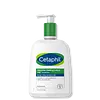What's inside
What's inside
 Key Ingredients
Key Ingredients

 Benefits
Benefits

 Concerns
Concerns

 Ingredients Side-by-side
Ingredients Side-by-side

Water
Skin ConditioningGlycerin
HumectantCaprylic/Capric Triglyceride
MaskingHelianthus Annuus Seed Oil
EmollientPentylene Glycol
Skin ConditioningButyrospermum Parkii Butter
Skin ConditioningCetearyl Alcohol
EmollientSorbitol
HumectantBehenyl Alcohol
EmollientGlyceryl Stearate
EmollientCyclopentasiloxane
EmollientTocopheryl Acetate
AntioxidantHydroxypalmitoyl Sphinganine
Skin ConditioningNiacinamide
SmoothingAllantoin
Skin ConditioningPanthenol
Skin ConditioningArginine
MaskingDisodium Ethylene Dicocamide PEG-15 Disulfate
CleansingGlyceryl Stearate Citrate
EmollientSodium PCA
HumectantCeteareth-20
CleansingSodium Polyacrylate
AbsorbentCaprylyl Glycol
EmollientCitric Acid
BufferingDimethiconol
EmollientDisodium EDTA
Sodium Hyaluronate
HumectantCetyl Alcohol
EmollientWater, Glycerin, Caprylic/Capric Triglyceride, Helianthus Annuus Seed Oil, Pentylene Glycol, Butyrospermum Parkii Butter, Cetearyl Alcohol, Sorbitol, Behenyl Alcohol, Glyceryl Stearate, Cyclopentasiloxane, Tocopheryl Acetate, Hydroxypalmitoyl Sphinganine, Niacinamide, Allantoin, Panthenol, Arginine, Disodium Ethylene Dicocamide PEG-15 Disulfate, Glyceryl Stearate Citrate, Sodium PCA, Ceteareth-20, Sodium Polyacrylate, Caprylyl Glycol, Citric Acid, Dimethiconol, Disodium EDTA, Sodium Hyaluronate, Cetyl Alcohol
Stearyl Glycyrrhetinate
Skin ConditioningWater
Skin ConditioningParaffinum Liquidum
EmollientPetrolatum
EmollientDipropylene Glycol
HumectantButylene Glycol
HumectantSqualane
EmollientGlycerin
HumectantGlyceryl Stearate Se
EmulsifyingCetearyl Alcohol
EmollientBehenyl Alcohol
EmollientGlycol Stearate
EmollientSerine
MaskingCeramide NP
Skin ConditioningTocopherol
AntioxidantUbiquinone
AntioxidantCetyl Ethylhexanoate
EmollientAcrylic Acid
Acrylates/C12-22 Alkyl Methacrylate Copolymer
Isostearic Acid
CleansingDisodium EDTA
Hydroxyethylcellulose
Emulsion StabilisingDimethicone
EmollientSodium Hydroxide
BufferingPhenoxyethanol
PreservativeStearyl Glycyrrhetinate, Water, Paraffinum Liquidum, Petrolatum, Dipropylene Glycol, Butylene Glycol, Squalane, Glycerin, Glyceryl Stearate Se, Cetearyl Alcohol, Behenyl Alcohol, Glycol Stearate, Serine, Ceramide NP, Tocopherol, Ubiquinone, Cetyl Ethylhexanoate, Acrylic Acid, Acrylates/C12-22 Alkyl Methacrylate Copolymer, Isostearic Acid, Disodium EDTA, Hydroxyethylcellulose, Dimethicone, Sodium Hydroxide, Phenoxyethanol
Ingredients Explained
These ingredients are found in both products.
Ingredients higher up in an ingredient list are typically present in a larger amount.
Behenyl Alcohol is a type of fatty alcohol (these are different from the drying, solvent alcohols).
Fatty Alcohols have hydrating properties and are most often used as an emollient or to thicken a product. They are usually derived from natural fats and oils; behenyl alcohol is derived from the fats of vegetable oils.
Emollients help keep your skin soft and hydrated by creating a film that traps moisture in.
In 2000, Behenyl Alcohol was approved by the US as medicine to reduce the duration of cold sores.
Learn more about Behenyl AlcoholCetearyl alcohol is a mixture of two fatty alcohols: cetyl alcohol and stearyl alcohol. It is mainly used as an emulsifier. Emulsifiers help prevent the separation of oils and products. Due to its composition, it can also be used to thicken a product or help create foam.
Cetearyl alcohol is an emollient. Emollients help soothe and hydrate the skin by trapping moisture.
Studies show Cetearyl alcohol is non-toxic and non-irritating. The FDA allows products labeled "alcohol-free" to have fatty alcohols.
This ingredient is usually derived from plant oils such as palm, vegetable, or coconut oils. There is debate on whether this ingredient will cause acne.
Due to the fatty acid base, this ingredient may not be Malassezia folliculitis safe.
Learn more about Cetearyl AlcoholDisodium EDTA plays a role in making products more stable by aiding other preservatives.
It is a chelating agent, meaning it neutralizes metal ions that may be found in a product.
Disodium EDTA is a salt of edetic acid and is found to be safe in cosmetic ingredients.
Learn more about Disodium EDTAGlycerin is already naturally found in your skin. It helps moisturize and protect your skin.
A study from 2016 found glycerin to be more effective as a humectant than AHAs and hyaluronic acid.
As a humectant, it helps the skin stay hydrated by pulling moisture to your skin. The low molecular weight of glycerin allows it to pull moisture into the deeper layers of your skin.
Hydrated skin improves your skin barrier; Your skin barrier helps protect against irritants and bacteria.
Glycerin has also been found to have antimicrobial and antiviral properties. Due to these properties, glycerin is often used in wound and burn treatments.
In cosmetics, glycerin is usually derived from plants such as soybean or palm. However, it can also be sourced from animals, such as tallow or animal fat.
This ingredient is organic, colorless, odorless, and non-toxic.
Glycerin is the name for this ingredient in American English. British English uses Glycerol/Glycerine.
Learn more about GlycerinWater. It's the most common cosmetic ingredient of all. You'll usually see it at the top of ingredient lists, meaning that it makes up the largest part of the product.
So why is it so popular? Water most often acts as a solvent - this means that it helps dissolve other ingredients into the formulation.
You'll also recognize water as that liquid we all need to stay alive. If you see this, drink a glass of water. Stay hydrated!
Learn more about Water